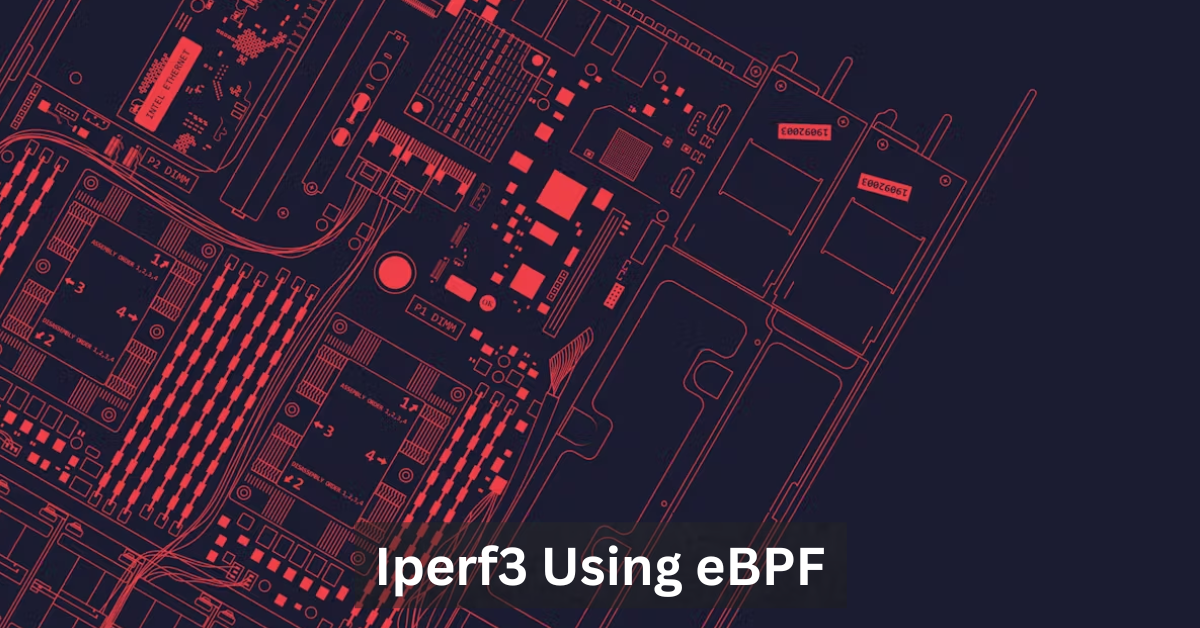Elevate Network Testing with Iperf3 Using eBPF Insights
In an era where network performance is critical, the integration of innovative tools is paramount. One such powerful combination is using Iperf3 Using eBPF alongside eBPF (Extended Berkeley Packet Filter). This article delves into how this combination enhances network performance testing, equipping network administrators with advanced capabilities to analyze, monitor, and optimize their networking environments.
Iperf3 Using eBPF is an open-source tool designed to measure bandwidth between two hosts. It provides detailed insights into network performance, helping administrators identify bottlenecks and optimize configurations. On the other hand, eBPF allows developers to run sandboxed programs in the Linux kernel without altering the kernel’s source code. This innovative technology facilitates deep packet inspection and dynamic tracing, making it an invaluable tool for network analysis.
Integrating Iperf3 Using eBPF with eBPF brings unprecedented advantages in network performance testing. By leveraging eBPF’s capabilities, Iperf3 Using eBPF can collect granular metrics, providing real-time data that is essential for troubleshooting and optimizing network performance. This integration not only enhances the accuracy of bandwidth measurements but also offers insights into latency, jitter, and packet loss, which are crucial for ensuring a robust network infrastructure.
What is Iperf3 Using eBPF?
Definition and Purpose of Iperf3 Using eBPF
Iperf3 Using eBPF is a network performance measurement tool primarily used for measuring the maximum TCP and UDP bandwidth performance. It serves a vital purpose in assessing the throughput capabilities of a network by generating traffic between two endpoints and measuring the data transfer rates.
Key Features and Functionalities
Iperf3 Using eBPF is equipped with various features that enhance its utility for network administrators. Key functionalities include:
- Bandwidth Measurement: Iperf3 Using eBPF enables accurate measurement of network throughput, making it an essential tool for assessing network capacity.
- TCP/UDP Performance Testing: Users can test both TCP and UDP protocols, providing flexibility for various network scenarios.
- Multithreading Support: This feature allows Iperf3 Using eBPF to utilize multiple threads, significantly improving test performance and enabling comprehensive testing of high-speed networks.
Bandwidth Measurement
The core function of Iperf3 Using eBPF is bandwidth measurement, which helps identify the maximum achievable data transmission rates between two hosts. By executing tests under different conditions, network administrators can determine optimal configurations for their network infrastructure.
Jitter and Packet Loss Analysis
Jitter and packet loss are critical metrics for evaluating network performance. Iperf3 Using eBPF provides detailed reports on these parameters, allowing users to assess the quality of service for applications sensitive to latency variations.
Multithreading Support
By supporting multithreading, Iperf3 Using eBPF can simulate multiple connections, providing a more realistic representation of network performance. This feature is especially beneficial for testing high-throughput environments, where simultaneous data streams are the norm.
Understanding eBPF
Definition of Extended Berkeley Packet Filter (eBPF)
eBPF is a powerful technology that extends the capabilities of the traditional Berkeley Packet Filter (BPF). It allows for executing custom programs in the Linux kernel, providing developers with a way to interact with and monitor the kernel’s behavior without requiring changes to the kernel itself.
Evolution of eBPF and Its Capabilities
Over the years, eBPF has evolved from a simple packet filtering tool to a comprehensive framework for executing arbitrary code in response to events in the kernel. This evolution has opened doors for numerous applications, including network performance monitoring, security enforcement, and observability.
Applications of eBPF in Networking
eBPF is widely used in various networking applications, such as:
- Packet Filtering with eBPF: Allows for sophisticated filtering of network packets, enabling precise control over network traffic.
- Monitoring Network Traffic: eBPF provides real-time insights into network performance, facilitating effective troubleshooting and optimization.
Benefits of Integrating Iperf3 Using eBPF with eBPF
Enhanced Performance Metrics
Integrating Iperf3 Using eBPF with eBPF significantly enhances performance metrics collection. This combination allows for detailed monitoring of network traffic, capturing metrics like throughput, latency, and packet loss with high accuracy.
Real-Time Data Collection and Analysis
One of the standout benefits of this integration is the ability to perform real-time data analysis. eBPF’s capabilities allow for the immediate collection of performance metrics, which can be crucial for diagnosing network issues as they occur.
Customization Options for Specific Testing Needs
The integration of Iperf3 Using eBPF and eBPF also provides customization options tailored to specific testing requirements. Network administrators can develop custom eBPF programs that cater to unique network conditions, ensuring more relevant and actionable data.
Setting Up the Environment
Prerequisites for Using Iperf3 Using eBPF with eBPF
Before integrating Iperf3 Using eBPF with eBPF, ensure that you have the following prerequisites:
- A Linux environment with the latest kernel supporting eBPF.
- Iperf3 Using eBPF installed on both testing endpoints.
- Basic familiarity with Linux command-line operations.
Step-by-Step Installation of Iperf3 Using eBPF
Installing Iperf3 Using eBPF is straightforward. You can use package managers like apt or yum to install it directly from your Linux distribution’s repository. Alternatively, you can build it from the source by following these steps:
- Clone the Iperf3 Using eBPF repository from GitHub.
- Navigate to the cloned directory.
- Run make to compile the code.
- Install the binary using make install.
Configuring eBPF on Linux Systems
To configure eBPF on your Linux system, ensure that your kernel supports eBPF features. You may need to install additional tools, such as bcc (BPF Compiler Collection), which provides utilities for writing and running eBPF programs.
Modifying Iperf3 Using eBPF to Utilize eBPF
Overview of the Integration Process
Integrating Iperf3 Using eBPF with eBPF involves several steps, including writing eBPF programs and modifying Iperf3 Using eBPF to utilize these programs for enhanced performance metrics.
Writing and Attaching eBPF Programs to Iperf3 Using eBPF
Creating custom eBPF programs involves using C or a higher-level programming language supported by the eBPF ecosystem. Once developed, these programs can be attached to various hooks in the Iperf3 Using eBPF execution flow, enabling the collection of specific metrics during tests.
Customizing Metrics with eBPF Scripts
By writing custom eBPF scripts, you can tailor the metrics collected by Iperf3 Using eBPF to suit your specific testing scenarios. This level of customization allows for in-depth analysis and optimization of network performance.
Practical Applications and Use Cases
Network Performance Testing Scenarios
Integrating Iperf3 Using eBPF with eBPF is beneficial across various scenarios, including data center operations, cloud environments, and enterprise networks. These tools enable network administrators to effectively measure and optimize performance in real-time.
Real-World Examples of Iperf3 Using eBPF and eBPF in Action
Several organizations have successfully leveraged this integration for improved network monitoring. For instance, cloud service providers utilize Iperf3 Using eBPF and eBPF to ensure that their services maintain high throughput and low latency for end-users.
Case Studies of Organizations Benefiting from This Integration
Organizations focusing on data-heavy applications have reported significant improvements in network performance by integrating Iperf3 Using eBPF with eBPF. These case studies illustrate the practical benefits of this powerful combination in real-world applications.
Challenges and Considerations
Common Challenges When Integrating Iperf3 Using eBPF with eBPF
While the benefits of integrating Iperf3 Using eBPF with eBPF are clear, challenges may arise, including compatibility issues with existing network infrastructure and the learning curve associated with eBPF programming.
Best Practices for Effective Implementation
To effectively implement the integration of Iperf3 Using eBPF and eBPF, consider the following best practices:
- Start with a Controlled Environment: Test the integration in a controlled environment before deploying it in production. This helps identify potential issues without impacting users.
- Leverage Documentation and Community Support: Utilize resources and documentation from both the iPerf and eBPF communities. Engaging with community forums can provide insights and solutions to common challenges.
- Regularly Update Your Tools: Ensure that both Iperf3 Using eBPF and the eBPF-related components are regularly updated. New features and optimizations are continually being introduced that could improve performance and security.
Performance Overhead and Compatibility Issues
While eBPF is designed to be lightweight, there can still be some performance overhead associated with running additional eBPF programs alongside Iperf3 Using eBPF. It’s crucial to monitor performance metrics and adjust configurations to minimize any negative impact. Additionally, compatibility between different Linux kernel versions and Iperf3 Using eBPF releases can pose challenges, so thorough testing is necessary before large-scale deployment.
Future Trends in Network Performance Testing
Emerging Technologies and Their Impact on Iperf3 Using eBPF and eBPF
As network environments evolve, emerging technologies such as 5G, IoT, and AI-driven analytics are influencing network performance testing methodologies. The integration of Iperf3 Using eBPF with eBPF positions these tools to take advantage of these trends, enabling more sophisticated and precise performance assessments.
Predictions for the Future of Network Testing Tools
The future of network testing tools will likely see increased automation and real-time analytics capabilities. Integrating machine learning algorithms with eBPF programs could lead to predictive analytics for network performance, allowing organizations to proactively address potential issues before they impact service.
The Role of Machine Learning and Advanced Analytics
Machine learning and advanced analytics will play a significant role in enhancing the capabilities of tools like Iperf3 Using eBPF and eBPF. These technologies can analyze vast amounts of performance data to identify patterns and anomalies, enabling faster and more informed decision-making regarding network configurations and optimizations.
Conclusion
The integration of Iperf3 Using eBPF with eBPF represents a significant advancement in network performance testing. By combining the robust bandwidth measurement capabilities of Iperf3 Using eBPF with the powerful, real-time insights provided by eBPF, network administrators can achieve a new level of visibility and control over their networking environments. This combination not only facilitates accurate performance assessments but also empowers organizations to optimize their network infrastructure effectively.
Frequently Asked Questions
What is the primary benefit of using Iperf3 Using eBPF with eBPF?
The primary benefit is enhanced performance metrics and real-time data analysis, which provide deeper insights into network performance.
Can I use Iperf3 Using eBPF without eBPF?
Yes, Iperf3 Using eBPF can be used independently, but integrating eBPF allows for more detailed and accurate performance monitoring.
What are the prerequisites for integrating Iperf3 Using eBPF with eBPF?
You need a Linux environment that supports eBPF, Iperf3 Using eBPF installed, and a basic understanding of Linux command-line operations.
How do I get started with writing eBPF programs for Iperf3 Using eBPF?
You can start by reviewing documentation on eBPF programming, exploring existing eBPF examples, and then creating custom scripts tailored to your testing needs.
Stay in touch to get more updates & alerts on Ancient-Artz! Thank you






